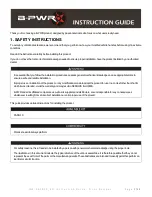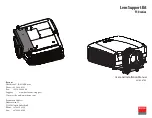
ó ïï ó
Collapsing the bicycle rack
The bicycle rack (1) is collapsed in reverse order.
Attaching/removing the bicycle rack to/from
the vehicle
Attaching the bicycle rack to the vehicle
1. Unlock the clamping lever (14) with the key (3).
2. Press lever (20) and move clamping lever (14) up.
3. Slide the support (21) horizontally onto the ball head (22) and
secure bicycle rack (1) against tilting.
4. Align the bicycle rack (1) parallel to the bumper and move the
clamping lever (14) down so that the lever (20) engages.
5. Lock the clamping lever (14) with the key (3). Pull out the
key (3).
6. Jiggle the rack (1) to ensure it is seated firmly.
It necessary, remove the bicycle rack (1) and reattach.
Ò±¬»
If you have adapted the position of the tail lamps (10) when
using the bicycle rack (1), (see Adjusting the lamps page 14),
then you must bring the tail lamps (10) back to their initial
position before collapsing the bicycle rack (1). Proceed in the
reverse order of that described in Adjusting the lamps.
߬¬»²¬·±²
The trailer hitch must be suitable for mounting a bicycle rack:
D-value of the ball head (see Technical data on page 9)
Material of trailer hitch at least St 52-3 (see type label on
trailer hitch)
If these instructions are not followed, the bicycle rack together
with the mounted bicycles may free themselves from the
vehicle and cause injury to you and other persons, or may
result in an accident.
The ball head must be cleaned and degreased prior to
mounting.
߬¬»²¬·±²
When the bicycle rack is attached to the vehicle, the tail lamps
must always be folded out.
The bicycle rack is not permitted to be used with the tail lamps
folded in. The lighting system must be checked to ensure it is
correctly positioned and working properly before every trip
(see Adjusting the lamps page 14).
߬¬»²¬·±²
Failure to note changed vehicle dimensions (width, height,
depth) with the bicycle rack attached may cause injury to
you and other persons and/or cause damage to property.
Please note the changed vehicle dimensions when driving
through entrances and narrow passages. Exercise care
when reversing.




































